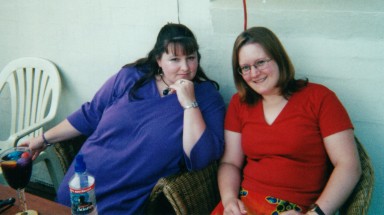
New Years Eve 2000-2001-the last chip binge!

After 16kg loss- I have only one chin!
Fiona's two cents on shaping up
|
|
|
Why would I put this here? In the hope that the information is useful to someone. I have done a lot of research on the topic and quite a bit of experimentation and my conclusion is that most people really don't have much accurate information about the subject, and a lot of published information doesn't give a true indication of what it takes to really lose weight and keep it off.. When I started my research many of my assumptions were based on the food pyramid studied at school, and on media advertising. It took a while to realise how influenced I was by these factors and how incorrect they were.
It took me a year to loose 16kg. Most of this time however, was working out how to do it, or resting in between. I lost the first 10kg in three months, then the second six in two 3kg blocks. Prior to this I had tried commercial weight loss programs (very very expensive!), celebrity diets/starvation/laxatives/meal replacements/pills etc.
There are three very important factors to loosing weight:
Food intake
Exercise
Frame of mind and knowledge
I found this out the hard way
after spending 4 months killing myself doing weights, followed by up to two
hours of cardio. I did this 3 times a week and didn’t loose a gram. I
couldn’t understand why- I wasn’t eating chips, donuts, cake etc, all ‘bad
foods’. Basically what I was doing was eating food that according to the food
pyramid was healthy- like pasta, bread and rice and ‘low fat’ alternatives
which I later discovered translates to ‘substitute fat for sugar’ (eg
low fat muffins, museli 'health' slices or breakfast bars and regular yoghurt).
These foods contained too much energy or hidden sugars.
I found the following website very
useful:
http://busycooks.about.com/library/features/blgifaq.htm,
I also spoke with several gym instructors who were very helpful. Some
instructors recommended protein powders, fat metaboliser tablets etc, and while
I think they have some effect in the short term, they are difficult to use for
long term loss and don't teach you how to maintain. Understanding food and
exercise is far more important.
The above mentioned site explains how sugar and carbohydrate stop weight loss. Some parts are similar to the Atkins diet used by starts such as Jennifer Anderson, but I modified parts in order to gain variety and flexibility. I also thought a lot about what people would have traditionally eaten and how much fast food and lack of necessary physical activity have affected us. The kind of food I used is similar to that in diets recommended to diabetics who use food to control insulin levels.
Fat is what is stored in the body, so sugar itself isn’t bad. However sugar is burnt first so if you are consuming foods containing or easily converted to sugar along with other foods, sugar will be used for energy first, and if the energy from other foods is not required it will be converted to fat. If you are not eating sugar, your body has to use fat as the main energy source. Simple carbohydrates like white bread, cake, etc are a source of very easily convertible energy so again will raise your blood sugar and be burnt first.
The main idea is to get your blood sugar on a flat level, rather than peaking up and down around mealtimes so that energy burning is continuous. This is done by eating more frequently and by eating foods that won’t cause blood sugar to rise very much. I eat three main meals and usually two snacks. Regular eating is important to keep blood sugars level and to keep metabolism going. You should always feel just full after eating, not bloated, not still hungry. If you don't eat enough your metabolism will slow after a while and it will become very hard to speed it up or lose weight. Do not starve yourself as initially weight may come off but it will be muscle and water.
Foods that affect blood sugars are given a glycemic index or GI rating. See the glycemic index of foods. A lot of info but basically you are cutting out foods which have high sugar/energy content. Obviously foods with high fat are out too. I eat mostly from the following:
In my experiments I found that complex
carbohydrates of some kind are very important in the morning. On days I didn’t
eat them, I felt flat and had a lingering headache.
Morning tea
Lunch
Any meat and vegies, soup, avoid fatty meats, rice, pasta
unless you are going to do exercise after eating.
Note- I avoided eating rice, pasta or bread when I was loosing, but these can be included in meals during maintenance periods. I always use artificial sweetener in tea and when I need a caffeine boost, I drink diet Pepsi or Coke as they contain no sugar (I hate the taste of coffee).
When I first started, I had withdrawals from sugar. The symptoms were a slight headache by the end of the first week and a drop in energy. I experimented with this and found that eating a spoon of sugar acted quickly to relieve the headache, showing that my sugar levels weren't stable enough. By the second week I had adjusted and noticed over time that I stopped craving sweet things, whereas previously I had in the middle to late afternoon. I also didn’t have a sleepy feeling after lunch anymore and my energy level was maintained throughout the day. Overall I would say I felt much better and didn’t have energy peaks followed by big lows. If I ate something sweet such as a biscuit, or a pasta/white bread based meal, particularly at lunch time, I got very sleepy quite soon afterwards, then craved more sweet things.
It is hard to measure the weight loss
using scales. Don't get disheartened when you first start as you may gain weight.
When you start exercising your scale weight is likely to go up as muscle bulk
increases, then go down as fat decreases. Try to get access to fat percentage
scales or use your old ‘skinny’ clothes as a measure.
Obviously mandatory! I lost the first 10kg simply by walking everyday for about 30-40mins. You need to spend that time walking at a pace where you can’t really hold a conversation. Strolling will not work, you need to be puffing! (although I have asthma, maybe other people can walk at high speed and talk!) Your body will burn sugar/carbohydrate first, then start on fat so you either need to walk for a long time or increase the speed to get a result.
The next six kgs took weight training to move and I would recommend that light weights are used from the beginning.. Cardio only burns fat to a point, then the body gets used to using less energy. Weight training, even if light will build muscle which burns much more energy than fat. More muscle means more continuous fat burning in between exercise. I have had several gym memberships and find them good for motivation, particularly in winter when the weather is bad, but the cheapest method is simply going to the park and doing a circuit of squats, leg raises, lunges, push ups/arm bends and situps in between fast walking. Increase muscle bulk and when the fat comes off, you will be able to see a much more toned shape.
Appendix 1- glycemic index info- from the website listed above, a bit American centric.
The following foods are considered unacceptable:
o Foods containing sugar, honey, molasses, & corn syrup.
o Fruits - bananas, watermelon, pineapple, raisins
o Vegetables - potatoes, corn, carrots, beets, turnips, parsnips
o Breads - all white breads, all white flour products, corn breads
o Grains - rice, rice products, millet, corn, corn products
o Pasta - thick, large pasta shapes
o Cereals - all cereals except those on the Low GI List below
o Snacks - potato chips, corn chips, popcorn, rice cakes, pretzels
o
Alcohol - beer, liqueurs, all liquor except red
wine
Fiona's note- although this list says no to some high sugar/starch fruits and
vegies, if you are craving something sweet you are far better off eating these
than junkfood. Eat watermelon in preference to chocolate!
Low
GI Foods
Look at what you can have:
o Foods sweetened with saccharin, aspartame, fructose
o All meats (I would avoid fatty bacon, beef, chicken skin, anything with fat)
o All dairy products (no sugars)
o Fruits - all except the High GI fruits above
o Vegetables - all except the High GI vegetables above
o Breads - whole rye, pumpernickel, whole wheat pita
o Grains - barley, bulgar, kasha
o Pasta - thin stands, whole wheat pasta, bean threads
o Cereals - Special K, All Bran, Fiber One, regular oatmeal
o Snacks - nuts, olives, cheese, pita chips, fried pork rinds (no way!!! As I said, American centric)
o Alcohol - red wine
o Misc - olives, eggs, peanut butter (no sugar)
GI Values
Here is
a list of common food products and their actual GI values. These numbers use
Glucose as a baseline, which is given a GI of 100. All the other values are
relative to glucose. It's surprising to see how certain foods compare to each
other.
Within each group, select your foods from those with the lowest values. If you must compromise, select foods with a moderate GI value. :
|
|